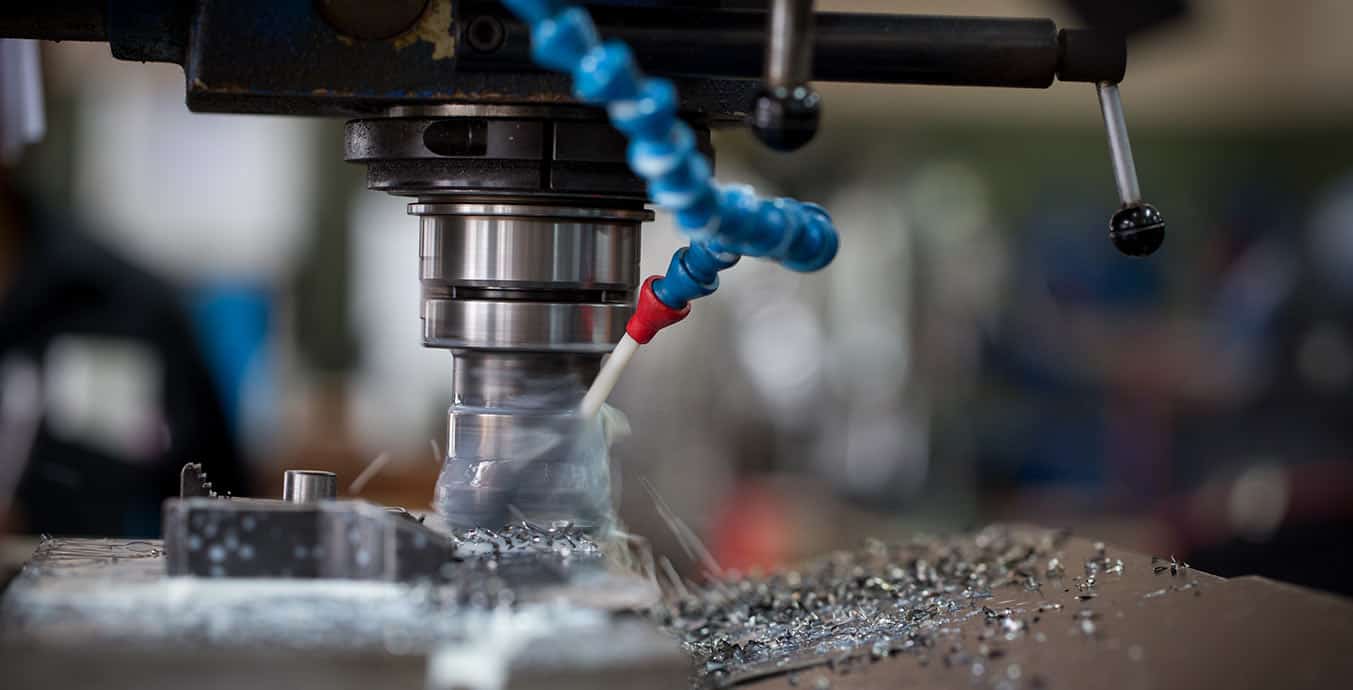
Cutting fluids are multi-purpose solutions designed for machining and metal-working processes where they act as both a coolant and lubricant. Cutting fluid is typically applied while work is taking place. They can be applied in various ways including mist spraying, flooding, and via a fluid jet. In this blog, we’ll take an in-depth look at these useful products and discuss which cutting fluid is the most common.
What cutting fluid is most often used in machine processes and why?
By far, soluble oils are the most common kind of cutting fluids employed in machining operations, and for good reasons. They have excellent cooling and fair lubricating attributes, but more importantly, they are the least expensive option available. Soluble oils, also known as emulsions, are best suited for applications where light cutting processes take place.
Soluble oils are classed as stable emulsions which are formed when mineral oil is added to water in specified measurements. The typical ratio used is 1% to 20% of oil to water. However, soluble oils contain other ingredients.
Emulsifiers like sodium sulfonate allow oil droplets to effectively combine with water by decreasing surface tension while biocides prevent bacteria growth. Anti-wear additives improve lubrication and special additives serve as coupling agents and improve resistance to corrosion. These additional elements in soluble oils will vary from product to product.
Other types of cutting fluid available
A diverse range of other cutting fluids are offered on the modern lubricant market. They are differentiated by source, phase, composition and by application method, but can be broadly categorised as straight oils, synthetic fluids, and semi-synthetic fluids.
Straight oils are mineral oils which do not form emulsions and are used without water. Vegetable and animal oils were once a common choice of pure oil lubricant in metalworking processes. While their biodegradability levels made them an eco-friendly option, they are expensive to buy and decompose quickly. As a result, today they are typically used only as additives to improve lubrication in petroleum or mineral oils. Petroleum-based hydrocarbons, mineral oils are obtained by refining crude oil. They can contain additives like chlorine, sulphur and phosphorus which are all extreme pressure (EP) additives which are included to mitigate tool wear.
Semi-synthetic fluids
These cleverly formulated solutions combine synthetic fluids, soluble oils, and water-based fluids. They typically contain a mixture of 5 to 50% mineral oil, chemical compounds and additives, which dissolve effectively in water to create microemulsions containing particle sizes of between 0.1mm to 0.01mm. Semi-synthetic fluids are designed to combine the properties of both synthetic fluids and soluble oils.
Synthetic fluids
Finally, synthetic fluids are lab formulated solutions with complex additives packages and the most expensive type of cutting-fluids available. Common additives included are designed to aid performance and lubrication and to inhibit rust and corrosion.
What are the functions of cutting fluids?
From soluble oils and straight oils to synthetic and semi-synthetic solutions, cutting fluids have multiple roles to perform which are as follows.
Lubricating
The key cause of excess heat during metalworking processes is friction. When heat and friction are combined, surfaces can become welded together. To avoid this unwanted effect, cutting fluids are used to reduce friction by forming a thin layer of oil between the tool and the chip, mitigating contact between them. Effective lubrication also reduces any abrasion on the cutting tool and can lower the required energy consumption of a metalworking process.
Cooling
In metal cutting machining processes, extreme heat is generated in the chips, workpiece and cutting tool by the friction between the surface of the workpiece and the cutting tool at work. Additionally, heat is generated due to the plastic deformation of metal at the shear zone. These high temperatures have a number of unwanted impacts, including thermal expansion and chemical reactions like oxidation. As mentioned earlier, welding of surfaces is also an issue. However, high quality cutting fluids can serve to cool the workpiece and tool efficiently preventing these problems occurring.
Preventing corrosion
Corrosion and rust inhibitors additives in cutting fluids stop both machine parts and machined surfaces from deteriorating. Mineral oil cutting fluids can prevent risks of oxidation by forming a thin but robust protective layer over all exposed surfaces.
Improving tool-life
By effectively dissipating heat, preventing rust and corrosion and reducing friction and abrasive forces, cutting fluids can greatly reduce wear on the tool, resulting in longer active service life for the component.
Removing chips
During specific metalworking processes like milling or drilling, chips will accumulate at the cutting zone. A chip build-up can inhibit effective cutting processes, but cutting fluids can help flush the debris away keeping the cutting zone clear for operations.
Improving surface finish
Finally, by preventing thermal expansion in a workpiece, carefully formulated cutting fluids can contribute to an enhanced surface finish for completed machined parts.








































